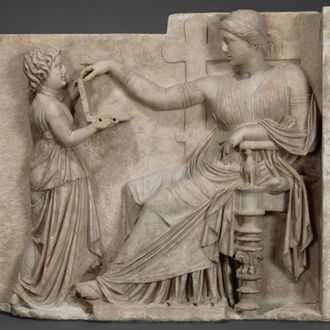
An ancient Greek sculpture crafted in 100 B.C. has finally fulfilled the purpose for which it was created: going viral on Facebook. The trending topic for the statue, “Ancient Greek Sculpture: Artwork Depicts What Some Say Is a Laptop Computer, Report Says,” is filled with tons of posts about the viral sculpture. Reports are saying that some are saying that it’s a laptop, and who am I to question that?
Grave Naiskos of an Enthroned Woman With an Attendant features a small child presenting something to a woman. Is it a laptop? The answer is “yes.” One hundred percent, absolutely “yes.” This is a laptop. The question: Are the USB ports on the side the new, versatile, future-proof USB-C, or are they the more limited USB 3.1 ports?
Or perhaps they’re proprietary Lightning ports? “Maybe it’s just a shallow box or something,” you say, like an imbecile. Wrong! It’s a laptop computer, which proves that time travel existed. How else would this arcane sculpture featuring a laptop computer — with genuine USB (HDMI, maybe?) ports on the side — have come into being?
Historians are unsure of what type of laptop is being held by the child, though, given the relative size, it’s probably a netbook or something in that range — definitely not a prosumer model. The USB port could have been used for a wide range of accessories, from ancient Greek trackpads to flash drives. The screen, according to my analysis, is 163 pixels per inch.
One thing is for sure, though: That’s a laptop in the ancient Greek statue. That’s indisputable.





























